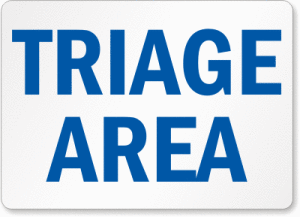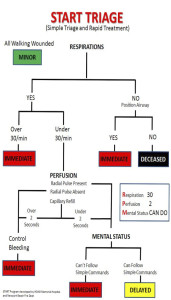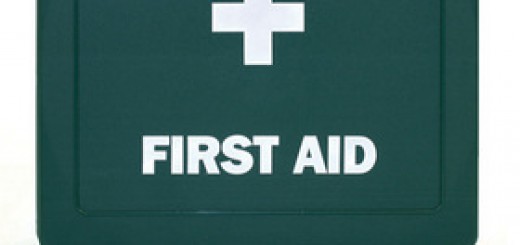A guide to triage for first aiders and first responders
Triage is the in itial assessment and sorting of casualties based on medical need and likely response to treatment.
itial assessment and sorting of casualties based on medical need and likely response to treatment.
In a multiple-casualty situation, triage is essential to effectively sort casualties and prioritise their order of treatment to ensure that the greatest good can be done for as many casualties as possible.
The principles of assessment and management can be used to determine the degree of urgency in the management of most casualties. Triage should be prioritised over treatment and only the following procedures should be carried out while assessing casualties:
- ensure that the airway is open
- control major bleeding
Triage is essential for managing multiple casualty events as it:
- prioritises treatment to use available resources as efficiently as possible
- ensures that care is focused on those casualties most likely to benefit from the limited resources available
- provides a framework for difficult and stressful life-and-death decisions creates order in a chaotic environment
Triage is initially performed to assess and apply priority in 30 to 60 seconds per casualty.
Triage must be:
- dynamic – effective, changing based on initial and following assessments and response to treatment
- safe – and evidence based
- fast
- reproducible – allow different personnel to arrive at the same decisions
This allows rescuers to allocate correct resources using minimal time and segregates casualties into groups, which allows rescuers to organise themselves and resources.
Triage methods

The START system (Simple Triage And Rapid Treatment) classifies a casualty’s treatment category from an assessment of their respiratory (respiratory rate), circulatory (capillary refill) and neurological (ability to obey simple commands/ functions).
Casualties are then attributed to one of the following four categories:
Immediate (red tag): casualties with life threatening but treatable injuries requiring immediate medical attention are assigned a red tag. These casualties are the first to be transported to hospital when medical help arrives, without delaying transportation for stabilisation
Urgent (orange or yellow tag): casualties with serious injuries, but able to wait a short time for treatment are assigned an orange tag
Delayed (green tag): casualties who can wait hours to days for treatment are assigned a green tag. These casualties can be separated from the more seriously injured by asking for casualties able to walk (i.e. ‘minor’ casualties) to congregate in a specified area
Dead (white or black tag): casualties who are dead or not expected to live because of the severity of their injuries and the limited resources available. These casualties are assigned either a white or black tag






Wow! This is really helpful to me as a rescuer, especially in a time of a large emergency situation. Thanks for this.